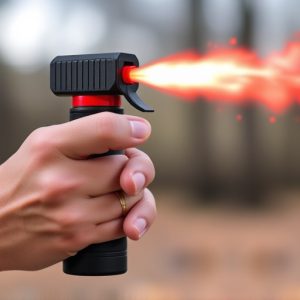Exploring Alternative Weapons for Self-Defense: A Comprehensive Guide to Non-Firearm Options
Alternative weapons to guns such as pepper spray, stun guns, and personal alarms serve as effective…….
Alternative weapons to guns such as pepper spray, stun guns, and personal alarms serve as effective, non-lethal self-defense options that are often less restrictive legally than traditional firearms. Pepper spray temporarily blinds and incapacitates an attacker through intense irritation, providing an opportunity for escape. Stun guns deliver a safe electric shock to subdue assailants without causing permanent harm. Personal alarms can deter potential aggressors with their loud noise. Individuals should evaluate the legality and their proficiency with these tools to ensure they are prepared for self-defense situations. Pepper spray and mace, which come in various forms like sprays, gels, and foams, stand out for their ease of use, safety, and accessibility as non-lethal alternatives to guns. Stun guns offer a controlled method of self-defense with simpler operation and less stringent regulations compared to firearms. Additionally, using common household items or natural self-defense strategies can provide protection without lethal force, emphasizing the importance of considering all legal and ethical options for personal safety beyond traditional weapons.
In today’s ever-evolving landscape of personal safety, individuals seek reliable and legal means for self-defense beyond traditional firearms. This article delves into the multifaceted world of non-firearm options for personal protection, highlighting the role of alternative weapons. From the effective use of pepper spray and mace to the advantages of stun guns, we explore a range of defensives that cater to various self-defense needs and scenarios. Additionally, we evaluate the efficacy and ethical considerations of utilizing everyday items as self-defense tools. Understanding these options is crucial for anyone looking to enhance their personal security without resorting to firearms.
Exploring Non-Firearm Options for Personal Protection: Understanding the Role of Alternative Weapons to Guns
When considering personal protection, it’s crucial to evaluate all viable options beyond firearms. Alternative weapons to guns play a significant role in self-defense strategies, offering methods of deterrence and defense that are often less lethal and more legally permissible in certain contexts. These non-firearm alternatives include a variety of tools designed for personal security, such as pepper spray, stun guns, and personal alarms. Pepper spray, for instance, is an effective, temporary means to incapacitate an assailant by causing intense irritation to the eyes and respiratory system, thus providing a clear opportunity for escape. Stun guns deliver an electric shock that can subdue an attacker without causing permanent injury, making them a popular choice for those seeking a less deadly form of defense. Personal alarms, on the other hand, serve as a deterrent by drawing attention to an incident, potentially scaring off would-be aggressors with their loud audible signals. Each of these alternatives requires careful consideration in terms of legality, effectiveness, and personal proficiency, ensuring that individuals can confidently rely on them in self-defense situations. Understanding the role of these non-firearm options is essential for anyone interested in exploring personal protection beyond traditional firearms.
Pepper Spray and Mace: Effective, Legal, and Versatile Self-Defense Solutions
Pepper spray and mace are non-lethal self-defense solutions that serve as effective alternatives to traditional firearms. These sprays utilize oleoresin capsicum, commonly known as pepper, which can incapacitate an attacker by causing intense irritation to the eyes, skin, and respiratory system upon contact. The effects are temporary yet potent, providing a critical window of opportunity for escaping a potentially dangerous situation. Unlike firearms, they do not require complex training or a deep understanding of ballistics, making them accessible to a wide range of individuals. Their legality varies by jurisdiction, but in many regions, pepper spray and mace are legal for civilians to carry, offering a lawful means of self-defense that is versatile enough for various scenarios.
The appeal of pepper spray and mace as self-defense weapons lies in their ease of use and the minimal risk of injury to both the user and the assailant. They are small and lightweight, allowing for easy concealment, which means they can be discreetly carried without drawing unwanted attention. Additionally, these sprays come in various forms, including keychain models, pepper gel, and foam-based options, catering to different preferences and scenarios. This versatility ensures that individuals can find a suitable self-defense weapon tailored to their needs, providing peace of mind and an alternative to carrying firearms for personal protection.
The Advantages of Stun Guns as a Safe and Controlled Self Defense Mechanism
Stun guns serve as a non-lethal, safer alternative to traditional firearms for self-defense purposes. Their primary advantage lies in their ability to incapacitate an attacker with a high-voltage electric shock, which can effectively neutralize a threat without causing permanent injury or death. This feature makes stun guns a compelling choice for individuals who prioritize safety and control when faced with potential harm. Unlike firearms, stun guns do not require extensive training to operate; their use is typically straightforward, involving little more than gripping the device and deploying the electric current upon contact with an assailant. Moreover, due to their electrical nature, stun guns can be less susceptible to misuse or accidental discharge compared to guns that fire projectiles. This reduced risk of unintended consequences is a significant benefit for those who wish to have a deterrent in challenging situations while maintaining a high level of safety for themselves and bystanders. Additionally, in many regions, the legal implications of using a stun gun are less severe than those associated with traditional firearms, which can be a critical consideration for potential users. Stun guns, as alternative weapons to guns, offer a controlled and effective means of self-defense that aligns with the desire for personal safety without the lethal potential of conventional arms.
Blunt Objects and Natural Defenses: Evaluating the Efficacy and Ethics of Everyday Items in Self-Defense Scenarios
In self-defense scenarios, individuals often find themselves in situations where access to traditional firearms is restricted or deemed inappropriate. In such cases, alternative weapons to guns become crucial for personal protection. Blunt objects, ubiquitous in everyday life, can serve as effective tools in these instances. The efficacy of blunt objects lies in their availability and the element of surprise they can provide during an altercation. Objects like baseball bats, heavy books, or a sturdy umbrella can deliver substantial force without the need for lethal outcomes. However, the ethical considerations of using these items cannot be overlooked. The intent is to incapacitate an aggressor until help arrives, not to cause undue harm. It’s important to choose and employ such objects responsibly, considering the potential for accidental injury or escalation of violence.
Nature itself offers a range of self-defense strategies that align with ethical considerations. Learning to use one’s body effectively, through techniques like striking with the elbow or using keys as makeshift defenses, can be both a legal and moral approach to personal safety. Similarly, understanding one’s environment and employing natural defensive maneuvers can be a powerful deterrent against threats. The use of environmental elements, such as throwing a rock to create distance or using natural terrain to one’s advantage, is a form of self-defense that requires skill and awareness rather than premeditated weapons. Both blunt objects and natural defenses serve as alternative weapons to guns, offering individuals options that align with personal safety while maintaining ethical boundaries in self-defense scenarios.


